- Home
- Algernon Blackwood
Ancient Sorceries And Other Weird Stories
Ancient Sorceries And Other Weird Stories Read online
Table of Contents
Title Page
Copyright Page
Introduction
Smith: An Episode in a Lodging-House
The Willows
The Insanity of Jones (A Study in Reincarnation)
Ancient Sorceries
The Man Who Found Out (A Nightmare)
The Wendigo
The Glamour of the Snow
The Man Whom the Trees Loved
Sand
EXPLANATORY NOTES
PENGUIN TWENTIETH-CENTURY CLASSICS
ANCIENT SORCERIES AND OTHER STRANGE TALES
Algernon Henry Blackwood was born in 1869 in Shooter’s Hill, Kent. Blackwood countered the strict religiosity of his early up-bringing by reading Buddhist tracts; he remained drawn to Eastern mysticism, theosophy, and occultism for his entire life. Trips to Canada and Switzerland nurtured a permanent devotion to nature. In 1890 Blackwood left England to seek his fortune in Canada. In 1892 he came to New York and worked as a reporter for several newspapers, including the Sun and the Times. By 1899 he was back in England. Blackwood’s first book of stories, The Empty House, appeared in 1906. The popular success of John Silence—Physician Extraordinary (1908) allowed him to settle in Switzerland and devote himself to full-time writing. During the next five years he produced a remarkable body of horror and fantasy fiction, including the story collections Pan’s Garden (1912) and Incredible Adventures (1914) and the novel The Centaur (1911). His children’s story A Prisoner in Fairyland (1913) was later adapted as a stage play, The Starlight Express, with incidental music by Edward Elgar. In the 1920s Blackwood devoted himself to writing plays, few of which were successful. In the 1930s and 1940s he became a fixture on BBC radio and also made several appearances on television. He narrowly ecaped death during the Blitz in 1940, as his lodgings in Hampstead took a direct hit from a German bomb. Algernon Blackwood died in London in 1951.
S. T. Joshi is a freelance writer and editor. He has edited H. P. Lovecraft’s collected fiction, poetry, and miscellaneous writings, and has produced editions of works by Lord Dunsany, Arthur Machen, and other writers of supernatural and fantasy fiction. Among his critical and biographical studies are The Weird Tale (1990), Lord Dunsany: Master of the Anglo-Irish Imagination (1995), H. P. Lovecraft: A Life (1996), and The Modern Weird Tale (2001). He has also edited Atheism: A Reader (2000) and the Penguin Twentieth-Century Classics editions of H. P. Lovecraft’s The Call of Cthulhu and Other Weird Stories and The Thing on the Doorstep and Other Weird Stories. He lives with his wife in Seattle, Washington.
PENGUIN BOOKS
Published by the Penguin Group
Penguin Group (USA) Inc., 375 Hudson Street,
New York, New York 10014, U.S.A.
Penguin Books Ltd, 80 Strand,
London WC2R 0RL, England
Penguin Books Australia Ltd, 250 Camberwell Road,
Camberwell, Victoria 3124, Australia
Penguin Books Canada Ltd, 10 Alcorn Avenue,
Toronto, Ontario, Canada M4V 3B2
Penguin Books India (P) Ltd, 11 Community Centre,
Panchsheel Park, New Delhi - 110 017, India
Penguin Books (NZ), cnr Airborne and Rosedale Roads,
Albany, Auckland 1310, New Zealand
Penguin Books (South Africa) (Pty) Ltd, 24 Sturdee Avenue,
Rosebank, Johannesburg 2196, South Africa
Penguin Books Ltd, Registered Offices:
80 Strand, London WC2R 0RL, England
First published in Penguin Books 2002
Introduction and notes copyright © S.. T. Joshi, 2002
All rights reserved
LIBRARY OF CONGRESS CATALOGING IN PUBLICATION DATA
Blackwood, Algernon, 1869-1951.
Ancient sorceries and other weird stories / Algernon Blackwood ; edited
with an introduction and notes by S. T. Joshi.
p. cm.
Includes bibliographical references.
eISBN : 978-1-101-15715-2
1. Fantasy fiction, English. 2. Horror tales, English. I. Joshi, S. T.,
1958- II. Title.
PR6003.L3 A83 2002
823’.912—dc21 2002072084
http://us.penguingroup.com
INTRODUCTION
Of mingled Irish, Scotch, and English blood, the first
predominated, and the Celtic element in him was strong.
A man of vigorous health, careless of gain, a wanderer, and by
his own choice something of an outcast, he led to the end the
existence of a rolling stone. He lived from hand to mouth, never
quite growing up. It seemed, indeed, that he never could grow up
in the accepted sense of the term, for his motto was the reverse of
nil admirari, and he found himself in a state of perpetual
astonishment at the mystery of things. He was for ever
deciphering the huge horoscope of Life, yet getting no
further than the House of Wonder, on whose cusp
surely he had been born [C 9].1
In this fashion are we introduced to Terence O’Malley, the protagonist of Algernon Blackwood’s spiritual autobiography, The Centaur (1911). In its short compass it could serve as a remarkably exact portrayal of the author, and only masses of detail are required to fill in the picture of one of the most distinctive literary figures of his time.
Blackwood lived his work as few authors have ever done. On the most superficial level, this means that he incorporated abundant autobiographical elements into his tales and novels, especially from his wide-ranging travels—from the wilds of the Canadian backwoods to the parched sands of Egypt; from the snowy crags of the Alps to the forbidding remoteness of the Caucasus Mountains. But there is far more to it than that. Virtually every one of the central figures in Blackwood’s fiction is a thinly disguised self-portrait, and of the most intimate sort—a self-portrait that probes the depths of his own complex and mystical temperament at the same time that it depicts the interaction of that temperament with the people and lands he encountered over a lifetime of unceasing wandering. What is more, Blackwood writes with so powerful a belief in what he is saying that he inexorably induces belief in the reader as well. However fantastic his imaginings, one gains the impression that Blackwood always means exactly what he says.
Algernon Blackwood was born on March 14, 1869, at Wood Lodge, Shooter’s Hill, Kent. He was the son of Stevenson Arthur Blackwood, who served in the Crimean War and subsequently became permanent secretary to the Post Office; he received a knighthood in 1887. Stevenson had become a fervent and evangelical Christian in 1856 and devoted much of his time to lay preaching; accordingly, young Algernon—whose family moved several times in his early childhood, finally settling at Shortlands House, Becken ham, Kent—grew up in a household of extreme religious strictness, with an emphasis on personal salvation and the heavy burden of sin. Matters were not helped by the year (1885-86) Blackwood spent in the “overstrict, semi-military discipline”2 of the School of the Moravian Brotherhood in the Black Forest of Germany, a period he would later depict vividly in the John Silence story “Secret Worship.” Blackwood escaped the oppressive religiosity of his family environment in a number of ways. Chief among them was his discovery, in 1886, of Buddhism, as embodied in Patanjali’s Yogi Aphorisms ; shortly thereafter he was absorbing books on spiritualism and theosophy. But these rebellions were only preliminary to his discovery of Nature (always with a capital N in Blackwood), a discovery that ultimately formed the core of his entire outlook on life:
By far the strongest influence in my life . . . was Nature; it betrayed its
elf early, growing in intensity with every year. Bringing comfort, companionship, inspiration, joy, the spell of Nature has remained dominant, a truly magical spell. Always immense and potent, the years have strengthened it. The early feeling that everything was alive, a dim sense that some kind of consciousness struggled through every form, even that a sort of inarticulate communication with this “other life” was possible, could I but discover the way—these moods coloured its opening wonder [EBT 36-37].
In a sense, Nature subsumed or incorporated all his other interests in occultism and spiritualism; for all these were merely vehicles toward the achieving of an “extended or expanded consciousness”3 that would lead to a kind of mystical bond with Nature. As Blackwood’s narrator describes O’Malley in The Centaur:
For the moods of Nature flowed through him—in him—like presences, potently evocative as the presences of persons, and with meanings equally various: the woods with love and tenderness; the sea with reverence and magic; plains and wide horizons with the melancholy peace and silence as of wise and old companions; and mountains with a splendid terror due to some want of comprehension in himself, caused probably by a spiritual remoteness from their mood.
The Cosmos, in a word, for him was psychical, and Nature’s moods were transcendental cosmic activities that induced in him these singular states of exaltation and expansion. She pushed wide the gateways of his deeper life. She entered, took possession, dipped his smaller self into her own enormous and enveloping personality [C 10].
The spell of Nature was not long in asserting itself: brief trips to Switzerland and Canada in 1887 and a walking tour in northern Italy in 1889 were only foretastes of what was to come.
Meanwhile, Blackwood’s formal schooling was not progressing especially well. He spent only a year at Edinburgh University (1888-89), ostensibly studying agriculture but more interested in pathology, psychology, and the occult. By this time he had already begun attending séances and exploring haunted houses in the company of a member of the Society for Psychical Research; he may also have become exposed to the Hermetic Order of the Golden Dawn—an occultist society that included as its members a number of England’s leading writers, among them W. B. Yeats and the Welsh supernaturalist Arthur Machen—although he did not formally join it until 1900. By 1891 he had also become a member of the Theosophical Society. But these groups ultimately proved unsatisfactory, as Blackwood realized that his own Nature-mysticism was too distinctive and nondoctrinal to fit into their narrow dogmas.
By 1890 Blackwood decided to seek his fortune in Canada. As a result of his extreme unworldliness and social clumsiness, he inadvertently offended a prominent official at the Canadian Pacific Railway, where he hoped to secure work, so he had to seek other opportunities. He accordingly teamed up with Alfred Cooper to establish a dairy farm near Toronto. Blackwood, whose business skills were (largely through lack of interest in mundane details of finance) rudimentary at best, quickly lost much of the £2000 he had invested in the business, and a subsequent venture—running a hotel and bar with a British friend, Johann Kay Pauw (disguised as “John Kay” in his autobiography, Episodes Before Thirty)—was equally disastrous. Another major move was in the offing—to New York.
It might be thought that the American megalopolis would be just about the last place for such a Nature worshiper as Blackwood, but he felt confident in his ability to secure work and even to find happiness of a sort. But the inevitable occured: although, by the fall of 1892, he had become a reporter for the New York Sun, the cumulative effect of his stay in New York could only be called psychologically devastating:
I seemed covered with sore and tender places into which New York rubbed salt and acid every hour of the day. It wounded, not alone because I felt unhappy, but of itself. It hit me where it pleased. The awful city, with its torrential, headlong life, held for me something of the monstrous. Everything about it was exaggerated. Its racing speed, its roofs amid the clouds with the canyon gulfs below, its gaudy avenues dripping gold that ran almost arm in arm with streets little better than sewers of human decay and misery, its frantic noise, both of voices and mechanism, its lavishly organized charity and boastful splendour, and its deep corruption in the grip of a heartless and degraded Tammany—it was all this that painted the horror into my imagination as of something monstrous, non-human, almost unearthly. It became, for me, a scab on the skin of the planet, brilliant with the hues of fever, moving all over with its teeming microbes. I felt it, indeed, but half civilized [EBT 124-25].
One suspects that Blackwood would have had this reaction even if a number of other events had not conspired to render his early days in New York even more wretched: a painful illness that incapacitated him for weeks; extreme poverty that compelled him to subsist largely upon dried apples (when eaten with water they would expand in his stomach and thereby ease his pangs of hunger); and, most phantasmagoric of all, his tortuous relationship with a thief and scoundrel, Arthur Bigge (disguised as “Boyde” in Episodes Before Thirty), who robbed Blackwood of what little money he had and whom Blackwood ultimately hunted down like an animal and had arrested.
But this was the nadir. By the fall of 1895 Blackwood had gained a much more tolerable position as a reporter for The New York Times, and in early 1897 he began a two-year stint as the private secretary for a wealthy philanthropist, James Speyer. This was probably the most pleasant phase of Blackwood’s New York period; a moose-hunting expedition in Canada in 1898 must also have helped by renewing his intimacy with Nature. And yet, Blackwood knew that these years of travail and anguish were the sources for his later literary work: “It was, perhaps, the undigested horror of those days, as also their unsatisfied yearnings after beauty, that tried to find expression fifteen years later in writing” (EBT 187).
By early 1899 Blackwood felt a yearning to return to his home-land, and by March he had resettled in England. But the wanderlust that remained an essential part of his nature was not slow to exert itself: in 1900 and 1901 he spent much of the summer canoeing down the Danube—trips that would ultimately be transmogrified into his most memorable weird tale, “The Willows.” Blackwood’s travels for the period 1902 to 1905 are not entirely clear; he appears to have gone to France, returned to the Black Forest and the school of the Moravians, and traveled throughout England, again absorbing impressions that would find their way into his later tales.
Was Blackwood giving any thought to a literary career? His earliest story, “A Mysterious House,” was published as early as 1889, and some articles had appeared in the Methodist Magazine and the theosophist journal Lucifer in the early 1890s. Blackwood had, by 1905, probably accumulated a substantial cache of fiction, but he seems to have made no particular effort to secure its book publication. Then a chance meeting with an old friend, Angus Hamilton, in early 1906 led to his submitting a collection of stories to the publisher Eveleigh Nash, who promptly accepted it. The Empty House and Other Ghost Stories appeared in late 1906 and was well received. The Listener and Other Stories—containing several of Blackwood’s most notable tales, including the title story, “The Willows,” “Max Hensig,” and “The Woman’s Ghost Story”—came out the following year.
But it was John Silence—Physician Extraordinary (1908) that definitively launched Blackwood on a literary career. Thanks to a clever advertising campaign, the volume became a best-seller and allowed Blackwood the freedom to devote the next six years to writing, without the need to worry about an income. He decided to settle in Switzerland, and in the next half decade produced some of the most remarkable work in the history of weird fiction: the collections The Lost Valley and Other Stories (1910), Pan’s Garden (1912), and Incredible Adventures (1914); the novels The Human Chord (1910) and The Centaur (1911); and the children’s fantasies Jimbo (1909) and The Education of Uncle Paul (1909).
It is difficult to generalize about these very diverse works; suffice it to say that they all tread the nebulous borderland between fantasy, awe, wonder, and horror. Awe is perhaps
the dominant motif; Blackwood is somehow able to invest the simplest events—or even his characters’ psychological reactions to those events—with a portentous grandeur, as if the very fabric of the universe is involved. That, indeed, is exactly what is involved in The Human Chord, a novel with one of the most distinctive premises in all weird fiction: the possibility that a “human chord” sung by four seemingly ordinary individuals could somehow reorganize all the matter in the cosmos. Or consider the several tales that Blackwood wrote after his 1912 visit to Egypt, among them “Sand” (in Pan’s Garden) and “A Descent into Egypt” (in Incredible Adventures). The latter’s climactic scene is nothing more than the tableau of three characters sitting around waiting for the dawn, and yet, few tales have ended more grippingly, as we see two hapless figures literally subsumed by the spell of Egypt:
I witnessed the disappearance of George Isley. There was a dreadful magic in the picture. The pair of them, small and distant below me in that little sandy hollow, stood out sharply defined as in a miniature. I saw their outlines neat and terrible like some ghastly inset against the enormous scenery. Though so close to me in actual space, they were centuries away in time. And a dim, vast shadow was about them that was not mere shadow of the ridges. It encompassed them; it moved, crawling over the sand, obliterating them. Within it, like insects lost in amber, they became visibly imprisoned, dwindled in size, borne deep away, absorbed [IE 331].
It is, indeed, interesting that pure horror is as prevalent as it is in these works. In “The Regeneration of Lord Ernie” (in Incredible Adventures), a character remarks of a sinister forest along a moun tainside: “There’s evil thinking up there, but by heaven it’s alive; it’s positive, ambitious, constructive.” He immediately qualifies this by saying: “Evil? . . . How can any force be evil? That’s merely a matter of direction” (IE 21, 23). Nature, no longer the intimately nurturing force that it is in the tales of awe, becomes malevolent and potentially destructive. But perhaps the fault rests not with Nature but with humankind: civilization has separated us from the natural world, and our alienation may have engendered in Nature an indifference that borders on hostility. The narrator of “The Wendigo” becomes aware of “that other aspect of the wilderness: the indifference to human life, the merciless spirit of desolation which took no note of man.” And consider the Swede’s comment in “The Willows”: “There are forces close here that could kill a herd of elephants in a second as easily as you or I could squash a fly. Our only chance is to keep perfectly still. Our insignificance perhaps may save us.”

 Day and Night Stories
Day and Night Stories Four Weird Tales
Four Weird Tales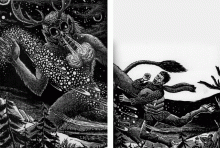 The Wendigo
The Wendigo Three More John Silence Stories
Three More John Silence Stories The Garden of Survival
The Garden of Survival The Extra Day
The Extra Day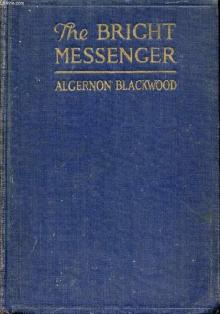 The Bright Messenger
The Bright Messenger Collected Works of Algernon Blackwood
Collected Works of Algernon Blackwood The Empty House
The Empty House Three John Silence Stories
Three John Silence Stories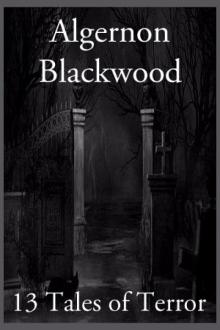 13 Tales of Terror
13 Tales of Terror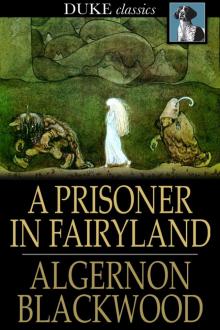 A Prisoner in Fairyland
A Prisoner in Fairyland Ancient Sorceries And Other Weird Stories
Ancient Sorceries And Other Weird Stories The Algernon Blackwood Collection
The Algernon Blackwood Collection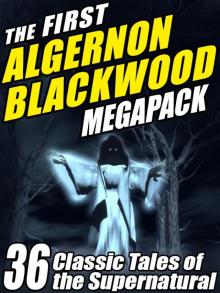 The First Algernon Blackwood Megapack: 36 Classic Tales of the Supernatural
The First Algernon Blackwood Megapack: 36 Classic Tales of the Supernatural John Silence, Physician Extraordinary
John Silence, Physician Extraordinary The Second Algernon Blackwood Megapack: 28 Classic Tales of the Supernatural
The Second Algernon Blackwood Megapack: 28 Classic Tales of the Supernatural The First Algernon Blackwood Megapack
The First Algernon Blackwood Megapack The Second Algernon Blackwood Megapack
The Second Algernon Blackwood Megapack